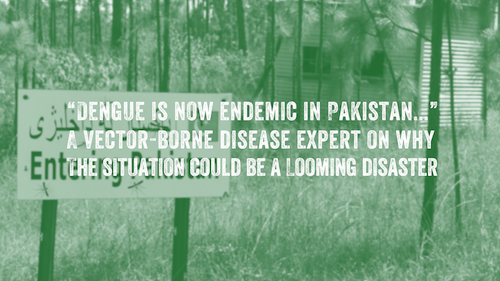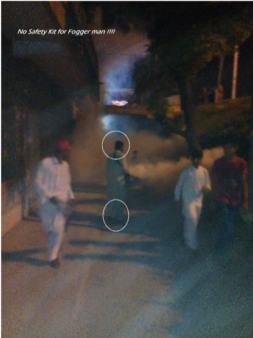- by Alison
Why the dengue situation in Pakistan could be a looming disaster…

“Dengue is now endemic in Pakistan…” said Dr. Muhammad Uzair Mukhtar from the Laboratory of Vector and Vector-Borne Disease at the Chinese Academy of Agricultural Sciences in Beijing. “It has been for the last ten years.” In an interview with Break Dengue, we explored the history of dengue in Pakistan, and he shared his most recent research and insights on what needs to be done to reduce the impact of this disease in the country.
What is the current status of dengue in Pakistan?
The first documented outbreaks of dengue in Pakistan were in 1994 in Karachi, when used tires imported from Thailand were the suspected source of the infection. But if you go back to the 1960s, there was one unconfirmed case of dengue in Pakistan.
Between 1994 and 2016 there were 71,649 cases with 797 deaths. 2010 was the worse year with almost 500 deaths in Karachi and Lahore. That year we had abnormal rainfall and flooding, compounded by people migrating from the cities to suburban areas.
Overall, the DENV2 dengue serotype is spreading across Pakistan – the same serotype detected in Karachi in 1994. Outbreaks started in the coastal region (including Karachi), then shifted to the lowland plains in 2011 (including Lahore) and to the highlands where there was a severe outbreak with deaths in Swat in 2013. Dengue shifted to cities in northern areas in 2017, where a severe outbreak led to 70 deaths. Only the arid region (the southeastern desert along with southwestern Balochistan) has not yet reported dengue.
What are the primary risk factors for dengue?
Recently, we studied the prevalence of dengue in Multan, located south of Punjab, to better understand the disease transmission dynamics and population at risk. It was Multan’s first dengue outbreak, and there were almost 1,000 cases of the disease recorded. Our data came from the Nishtar Hospital, where there were 689 suspected dengue patients – 373 confirmed.
The research concluded that around 11% of cases occurred during the rainy monsoon season (which runs from July to October) and the remainder in the months after – with no cases during the dry season. It also found most of those affected were aged between 21 and 49, and male. Our advice is that males should cover up, wear full-length sleeves as females do, and use insect repellent during the peak dengue season.
Add your name to the petition for an official, international World Dengue Day
We shared these recommendations with the health authorities during our routine case meetings. But Pakistan also needs to act to reduce mosquito populations before outbreaks occur – and embed these ideas in the minds of its people.
What would you like to see change?
In another study connected to dengue activity in Rawalpindi, we concluded that increased urbanization, insufficient water supply and inefficient removal of urban trash led to more non-biodegradable containers around human dwellings. These offered ideal breeding habitats for Aedes aegypti, which prefer roof-top water tanks and evaporative room coolers, followed by discarded tires and urban trash.

“SOPs are not working well.” An unprotected team fogging in Pakistan. Image courtesy of Dr. Uzair
Bearing these findings in mind, we want governments and communities to remember vector control even after the peak dengue season. And we would like to see a shift towards Integrated Vector Management (IVM) designed to optimize the use of resources for effective vector control that is also cost-effective. IVM encompasses capacity building, inter-sector collaborations, an integrated approach, advocacy, and social mobilization, legislation, and evidence-based decision-making.
Pakistan already has advocacy initiatives through local governments, local representatives and the community, but it needs more public health education. And the standard operating procedures – for chemicals, for clothing, for dengue intervention – that are in place at a national and a provincial level are not working very well. On paper, they look good, but they are not fully implemented on the ground and are not providing the desired results.
Basically, there’s no permanent infrastructure for vector-borne diseases in Pakistan. Vector-borne disease control is a small section under the health department. When outbreaks happen, the dengue intervention begins – from inside a small section of the health department. It recruits untrained local people as field staff for dengue vector surveillance; the medical entomologists and the vector control experts needed are not there on a regular basis.
Do you have concerns regarding the current state of dengue control?
Vector control in Pakistan mainly involves chemical control using larvicides and adulticides. Temephos has been used as a larvicide in Pakistan since 1969. Everyone believed it was working well, with the larvae of the mosquito susceptible. But when we started looking into the insecticide susceptibility of Aedes aegypti and Aedes albopictus larvae in dengue-affected urban areas in Rawalpindi, we found mild resistance. Later, in 2016, a follow-up study confirmed emerging resistance of temephos in Aedes larvae in Rawalpindi.
For adulticides, a 2011 study reported a low level of resistance for DDT, malathion, and bendiocarb with the Malaria and dengue vectors. Five years later, we conducted the same study in Rawalpindi and found resistance for DDT, malathion, and bendiocarb, with mortality less than 90%. For deltamethrin and Lambda-cyhalothrin we found probable resistance present, with mortality was less than 97%.
With insecticides, the backbone of vector control in Pakistan, not having effective chemicals available in the future would be a disaster.
What’s needed to fortify dengue prevention in Pakistan?
The dengue situation in Pakistan is not good. It needs attention. After all, healthcare is critical to improving the daily lives of the people of Pakistan.
There is a lot of scope for research into dengue in Pakistan, but we need more resources, we need funding, and we need technical support from developed countries. There is an urgent need for an institute in Pakistan that yields medical entomologists and provides facilities for qualitative research on dengue and other vector-borne diseases.
Regarding the economic burden of dengue in Pakistan, for instance, I plan to conduct Knowledge, Attitude, and Practices (KAP) studies, and in these, I will include socio-economic factors and demographic factors in the dengue endemic areas of Pakistan.
—
Reduce the impact of dengue near you. Click below to report local dengue fever activity using Dengue Track.

